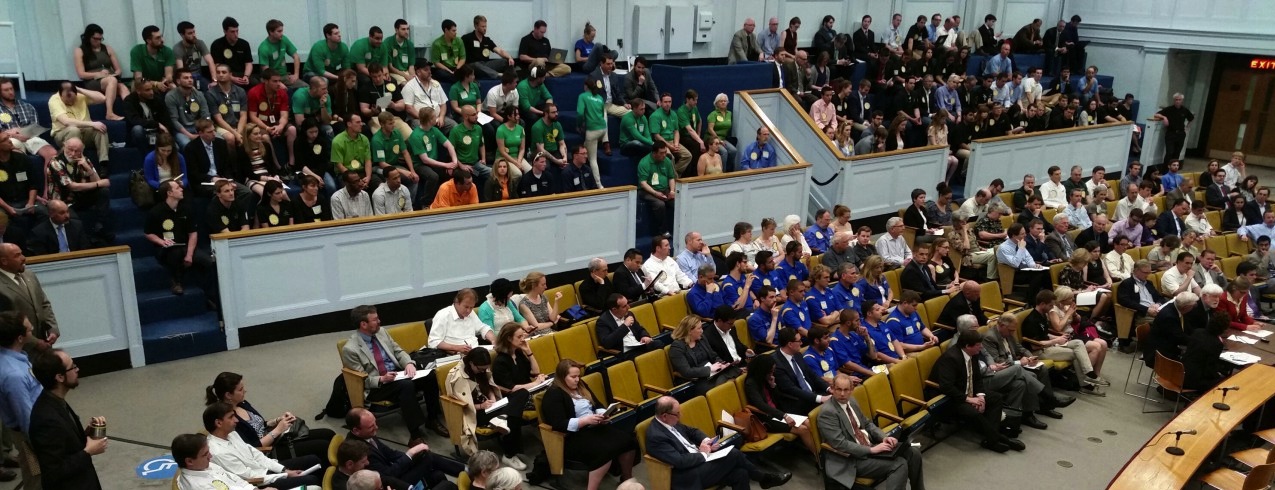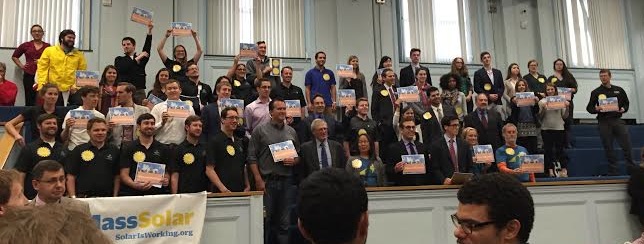Early this month, over 200 clean-energy activists, Sierra Club members, and solar power developers gathered at the State House in Boston to discuss the future of solar energy in Massachusetts. The hearing featured state energy officials and utility representatives, and covered the topic of net metering, a law that has propelled solar into some of the fastest growth of any industry during the recession.
Net metering is one way that owners of rooftop solar can be compensated for their production of energy. The sun, naturally, does not shine all the time, but on very sunny days many rooftop panels produce more electricity than their attached households need. On such occasions, the extra juice goes back to the utility, to the extent that some utilities can turn off their gas pipelines while solar is peaking. In compensation, the owners of the solar panels are paid for their energy at market rate, which can be as high as 16 cents per kilowatt-hour. Under net metering, households with good locations for solar panels can end up with zero electricity bills.
However, as the law stands, net metering comes with a ‘cap,’ that is, a limit on the percentage of energy coming from solar during peak production by a utility. In the last few years, the cap has been rising steadily, from 6 percent of production to 9 percent since 2014 alone, but the Massachusetts solar industry is booming so rapidly that this cap has already been reached in some utility territories.
Reaching the cap is a huge problem for solar industry, since further solar capacity would not be eligible for net metering. And since net metering is a useful incentive for households to install solar panels, a lack of net metering means less solar growth and new solar projects getting stuck in regulatory limbo. Yet, in the last five years, the number of employees working for the Massachusetts solar industry has grown from nearly zero to over 12,000, a major source of jobs during what has otherwise been an economic slump.
The purpose of the net metering hearing was to discuss where the state should go from here, specifically, whether the cap should be raised from 9 percent. The state and industry representatives stood against the cap being raised, at least not until a “long term solution” has been found. However, state officials had no suggestions as to what such a solution might look like. The industry has even proposed a “minimum bill” that would charge households a baseline fee, regardless of whether or not they were producing more electricity than they used.
The Sierra Club, in partnership with solar power promoters such as Solar Design Associates, has proposed a different option. Currently, single-phase solar projects under 10 kilowatts do not count toward this cap, and can still benefit from net metering. Unfortunately, that still leaves out a large proportion of household and community solar. Community solar “gardens” are of particular concern, since 80 percent of households in Massachusetts cannot install solar panels, owing to factors such shade, angle of exposure, or lack of home ownership. The new solar bill, to be proposed in the state legislature in July, would keep the caps at 9 percent, but would exclude all solar projects smaller than 1 megawatt, thus including all residential and community solar but leaving out utility-scale projects. This new long-term solution would allow solar to grow, while still compensating citizens for producing electricity for the grid.
“For every dollar invested in solar, you get more than double the return,” says Haskell Werlin, solar activist and business director of Solar Design Associates, citing a recent study of the value of solar. “The utilities are on the warpath, and think we’re a pesky pain the butt. But we should be partners. We should be giving them money to promote renewables, not taking it away. But the companies like to say that solar is too expensive. Well, gas is too expensive. It’s better than other fossil fuels, but better than bad isn’t good enough.”
Back at the hearing, the vast majority of the crowd was for raising the caps, with only the state and industry officials making statements against. According to Werlin, most of the crowd was composed of young solar installation professionals, twenty-somethings with green jobs. The overflowing crowds extended the hearing for hours, and although exact counts are not available, Werlin recalls printing 400 pro-solar stickers for the two-day lobbying event (many are visible in the photo of the hearing, below). “I gave out 130 the first day,” he says. “They ran out on the second.”
Despite its small size, Massachusetts’ net metering policy has made the state the fourth-largest solar producer in the country, reducing pollution and invigorating the economy in one stroke. And as long as this policy remains in place, the future for rooftop solar looks bright.

